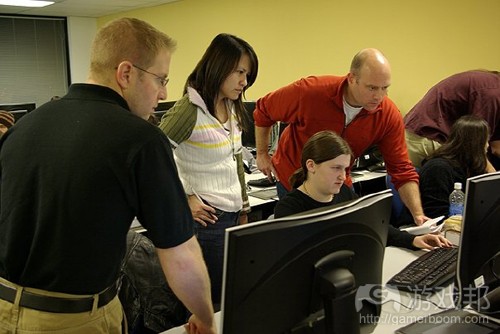阐述衡量游戏设计师价值的3大标准
作者:Kain Shin
在同朋友谈及游戏内外合作项目时,我想到这样一个问题:
高质量产品没有设计师能否完成?
我们得出的结论是满足某些条件便“能够”,只要下述方面有一点成立:
1. 所有团队成员都能在方案落实前理清要素脉络。
2. 有足够时间反复试验糟糕想法,直至它们变得可行。
时间很少毫无限制,信任所有团队成员,保持一致观点通常具有风险性。因此,多数项目设有人员辅助团队在落实各细节内容前将其具体化。
在游戏行业,负责这些任务的人被称作制作人、主管、项目经理、产品负责人、设计师或规划人员。这些角色具有两面性:
* 思考细节问题是其主要工作
* 思考成本远低于执行成本(执行任务将逐步消失)
那么什么是“产品负责人”标准?
我认为在所有行业中,负责人角色都包含3方面内容:
1. 预先勾勒
设计师在将资源转换成设计前,脑中模拟能力如何?没有人在此完美无瑕,反复性体现在任何包合作创造的行业中。
两种方式挖掘问题解决方案:
* 其一就是随意切入,直至找到解决方案,他们能够识别解决方案。
* 其二把问题同定义成败条件的心理模式联系起来,那么实验就能在此心理模式下有条不紊呈现。
“有条理”设计师的消耗成本比“随意性”设计师少得多。
以下预先勾勒包含的问题示例:
* 设计包含Y限制因素的X产品
* 若制作X会出现什么情况?
* 解决此开放式问题
2. 把构思转换成语言
预先勾勒发生在设计师脑中,但这项工作需借助可靠渠道,以便把构思转换成脑外富有意义的任务。
团队成员(包括设计师)或许没有足够信息发挥其作用。将构思转换成系列语言较把句子转换成编码而言对产品的影响更大。
我所知道的优秀设计师不仅传递其构思,还向团队传达其背后哲理。这些设计师扮演的是创意导师角色,通过优质美学效果感染团队其他成员。这个细节之外的推理传达让操作者能在他们的决策过程中融入设计核心价值。
沟通当中的问题示例:
* 形容你喜欢/讨厌的产品,说明其好/不好在哪里?
* 告知我们如何完成你所擅长的复杂任务
* 解决此开放问题,适时提问问题
3. 关系处理
沟通或许已非常清晰,但争执仍会出现。大家不会盲目跟从。除非设计师打算独自进行项目,否则就要应对人力因素。
我看过老练设计师在此栽跟斗。模式大同小异:
* 他们非常熟练,能力突出(游戏邦注:或者有些过于自信)。
* 他们希望能够被大家喜欢(如赞同)。
* 他们反对不喜欢他们的人士(如不同意)。
* 权威人物发现成本高过收益
或者换个角度,大家因为成员之间的关系出现问题,或者无法正常发挥作用而离开团队。
关系学入门只需一分钟,但要一生才能参透。
结论
很少开发商说自己是糟糕设计师(游戏邦注:很多身处开发团队的人员都坚信自己是优秀设计师)。我想这同有人认为自己喜欢美食就是好厨师的想法一样。
不论游戏内外,设计原则决定产品最终美学效果。设计、规划以及产品确认都是基于技能的学问,其中3大参照标准是此学问的水平标准。
若你要设计设计师面试方案,不妨将3大RPG(角色扮演游戏)属性融入其中:
* 预先勾画
* 沟通
* 交际手腕
若你面试设计师,上述3个方面会是非常好的参考标准。(本文为游戏邦/gamerboom.com编译,如需转载请联系:游戏邦)
Measuring a Designer’s Value
by Kain Shin
In discussions with friends who work on collaborative projects in and outside of games, one question came to mind:
Can a QUALITY product be completed WITHOUT a designer?
The conclusion we came to was a conditional “yes”, but only if either of these two things were true:
1. Each member of the team was fully capable of cohesively visualizing the ramifications of their component before actually implementing it
2. There was infinite time to iterate on the implementation of bad ideas until they become good ideas
Time is rarely infinite and trusting everyone on the team to maintain a cohesive vision of the product can be a gamble. For that reason, most projects will involve people whose role it is to supplement the team’s ability to visualize the details before time and resources are spent on the implementation of those details.
Depending on the industry, the people that perform these functions hold titles such as Producers, Directors, Project Managers, Product Owners, Designers, or Planners. The idea behind these roles is two-fold:
* Thinking about ramifications warrants a fulltime job
* The cost of thinking is cheaper than the cost of doing implementation work that will be discarded
So… what are the metrics of a “product owner”?
I believe that every industry can distill the evaluation of this pivotal role into three distinct categories:
1. Pre-Visualization
How good is the designer at running simulations in the brain before committing resources to the design? Nobody will be perfect at this… iterations will be a fact of life in any industry involving collaborative creation of product.
There are two ways to derive a solution to a problem:
* One way is to throw random darts at the problem until a solution hits… and hopefully they will recognize the solution when they see it
* The other way is to incorporate the problem into a mental model with an effort to define success and failure conditions so that experiments might be methodically mapped within this mental framework
The “methodical” designer will cost production less money than the “random darts” designer.
Sample Pre-Visualization Screening Questions:
* Design a product about X with constraints Y
* What would happen if you do X?
* Solve this open-ended problem
2. Converting Thoughts to/from Language
Pre-Visualizion takes place inside the designer’s head, but that work needs a reliable channel in order be converted into meaningful tasks outside the head.
Team members (including the designer) may not have all of the information needed to perform their function. The translation of ideas into sequential words within a sentence can certainly have more influence on the product than the translation of sentences into code.
The best designers I know have a way of communicating not just their ideas, but also the philosophy behind their ideas to the team. These designers serve as a creative mentor infecting the rest of the team with a galvanizing aesthetic compass. This transferrence of reasoning in addition to details gives implementors an opportunity to incorporate the core values of the design into their own decision-making process.
Sample Communication Screening Questions:
* Describe a product you like/hate and explain why it is good/bad
* Teach us how to do something complex that you are an expert at
* Solve this open-ended problem… ask questions as needed
3. Managing Relationships
Even though communication may be clear, debates may still occur. People will not neccesarily follow blindly. Unless the designer is going to work alone, this person will need to deal with people factors.
I have seen many highly skilled designers felled by a fatal flaw in this particular category. The pattern was often the same:
* Person is highly skilled and competent (or just overly confident)…
* Person expects everybody to be like them (i.e. agrees)…
* Person antagonizes people who are not like them (i.e. disagrees)…
* An authority figure (or figures) realizes that the cost outweighs the benefit
… or in the other direction, people quit the team or become dysfunctional because of this breakdown in relationships.
Like othello, the science of relationships is said to take a minute to learn and a lifetime to master.
Conclusion
Few developers ever say that they are a bad designer. Most people on a development team firmly believe that they are good designers; I suspect that this may be the same proportion of people who believe that they are good at cooking food because they are consumers of food.
Whether in or outside of games, the design discipline is responsible for managing the target aesthetics of the final product. Design, Planning, and/or Product Owning is a skill-based discipline with three categories of metrics that serve as qualifiers of competency within that discipline.
If you find yourself in a position to develop an interview process for a design position, then feel free to incorporate three RPG stat trees into your interview process if you haven’t already:
* Pre-Visualization
* Communication
* Diplomacy
… and if you are in a position to interview for the position of “designer”, then it wouldn’t hurt to consider where you might fall within each of these three stats. (Source:gamasutra)
上一篇:游戏剧情设计小技巧之拯救台词篇









































